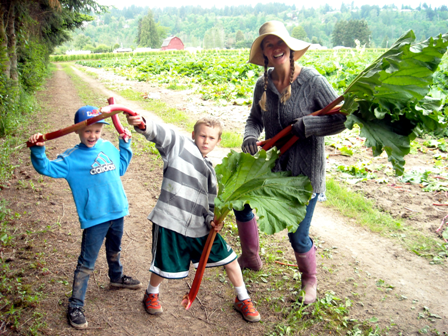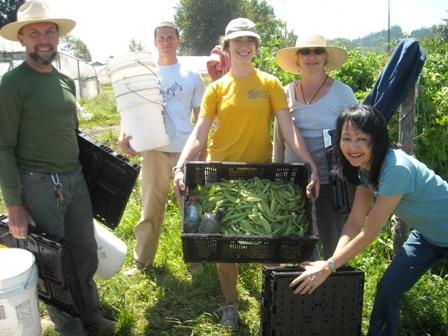Fruit Tree Donor Relations

New Fruit Tree donors hear about the program through neighbor donors and word of mouth, tabling at events, newspaper articles, and community talks. A local newspaper highlighted the project in 2012 and brought a handful of new donors. The project has produced a number of helpful outreach materials such as the PCGP Postcard and simple flyer and a fruit tree magnet with our phone number. Tree owners can register online, using the Tree Owner Application or just by calling the designated call-in number at our partner food bank organization, the Food Connection, to set up a harvest.
Registered fruit tree owners are tracked in a Fruit Tree Owners List spreadsheet. To retain fruit tree donors, the PCGP coordinator made reminder emails or calls twice a year; once before the harvest season and once mid-way through to those whose properties hadn’t been harvested yet. To show appreciation, the coordinator thanked fruit tree owners in person or left a “thank you” card with the total pounds picked, volunteer signatures, and where it was delivered. Additionally, at the end of the year the coordinator sent “thank you” letters sharing the total pounds donated through all of the fruit harvests and included a fruit tree magnet so that the donor could easily remember the number to call-in their tree for the next year.
Farm Donor Relations
The greatest challenge when approaching farm donors is assuring the farmer they will not be held liable if an accident occurs, or if there is an illness from consuming the gleaned produce. Our assurance is that liability for accidents is not an issue because all volunteers sign EFN's Volunteer Waiver. No donor can be held accountable for illnesses that result from consuming donated goods, as specified in the Good Samaritan Law.
It’s recommended to start with a few farm donors in the first year to build trust with the farmers. The best method to find farmers is through a personal connection or introduction. The PCGP was fortunate to have that connection and introduction through two individuals: The farmer at the EFN’s Mother Earth food bank farm, and a WSU extension agent. The Mother Earth farmer helped PCGP connect with smaller scale, organic growers by inviting the coordinator to speak at a spring meeting for Pierce Tilth, an organization of organic and sustainable farmers. WSU extension agents essentially work with local farmers to apply agricultural knowledge gained from research at the University and help community members connect with local farmers. The WSU agent informed the coordinator of certain larger scale farmers who may be interested in gleaning. The agent had the preliminary conversation with those farmers before inviting the coordinator to call them and follow up. As a result, the PCGP built relationships with three local small-scale organic farmers and one large-scale commercial green bean farmer in 2011.
In 2012, the PCGP was able to continue the pre-existing relationships and use these connections to build new relationships with farmers in the area. The gleaning coordinator thanked farmers online after big gleans and got a newspaper article published featuring a new farm partner.
When building relationships with farm donors, it is helpful to remember that there are different ways to glean farms. The PCGP gleans farms in three different ways:
-
Field Gleaning – small scale farms, including Community Supported Agriculture (CSAs) and other farms equipped for outsiders coming onto the farm.
-
Cull Gleaning – small to large scale farms, a great way to get leftover market produce from a smaller farm’s cooler, and to engage the larger-scale farmer by dropping off boxes for them to fill with non-market grade produce during the harvest.
-
Farmers Market Gleaning – great way to capture any excess produce, milk or bread from vendors at farmers markets featuring produce (and not predominantly crafts or prepared foods).
To retain farm donors, it is important to be consistent, bring trained volunteers, and take as little time out of the farmer’s day as possible. The PCGP coordinator called farmers once a week or in the height of season or according to their crop schedule to stay on their radar. Appreciation was shown with verbal thanks, EFN's Donation Receipt upon pickup, and an end-of-season thank you card including their total donations and an invitation to the end-of-year celebration.
Plant-a-Row Gardener Donor Relations
To connect gardeners with their nearest food banks, the PCGP promoted a Plant a Row for the Hungry campaign in collaboration with our community garden Share the Harvest Program. This consisted of giving out free seeds, plant starts, and information on Produce Donation Sites, based on a survey of the 67 county food banks. The gleaning coordinator wrote Seed Donation Letters to local producers for donations and distributed over 700 seed packets at all the Pierce County Library branches in the spring of 2012. Additional seeds were distributed at three food banks, a community seed swap, and other outreach events. Donated seeds that needed an early start were grown into 12,000 plants in greenhouses at local schools, farms, and a biosolids treatment plant – which cleans the city’s sewage waste and produces a home gardening fertilizer from the solid waste. The plant starts were initially distributed at the Community Gardening Summit in spring of 2012. To get a snapshot of the overall impact gardeners make on alleviating hunger, the gleaning coordinator began working with key food banks to track garden donations on a monthly basis.
The most important part of developing donor relations with gardeners is providing an accurate list of where they can donate small amounts of produce. Many gardeners simply don’t know that they can walk into a food bank with their produce for donation, so surveying area food banks to find which food banks are interested is highly recommended.



